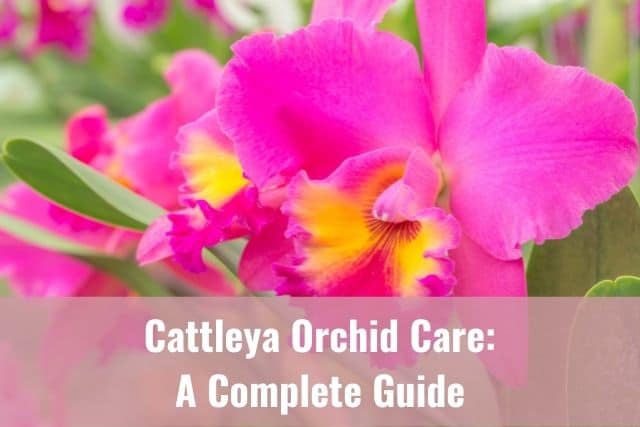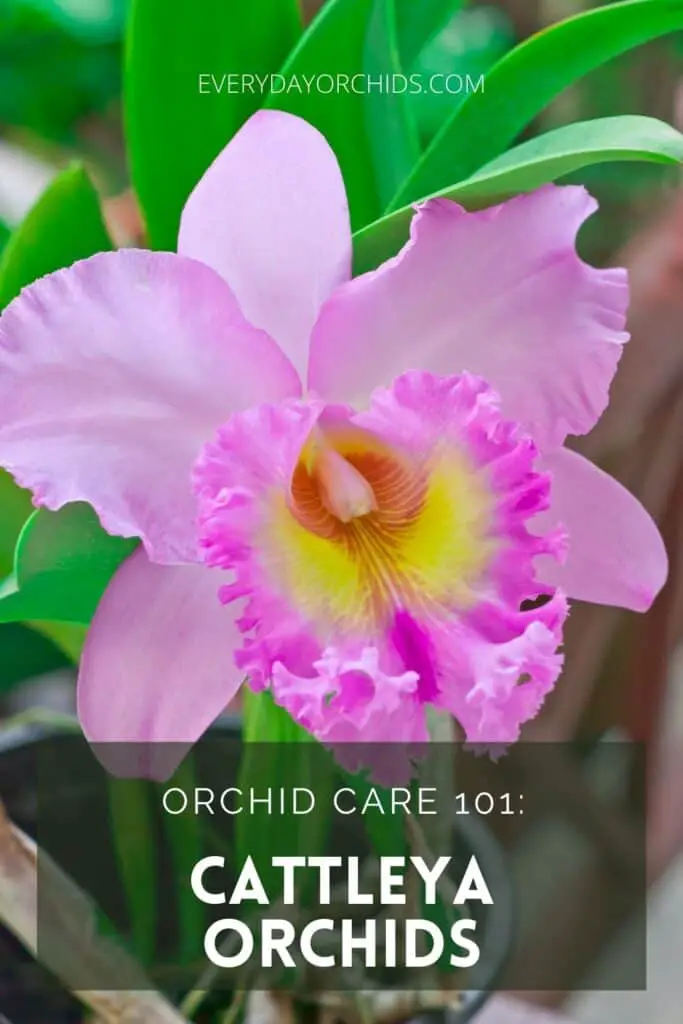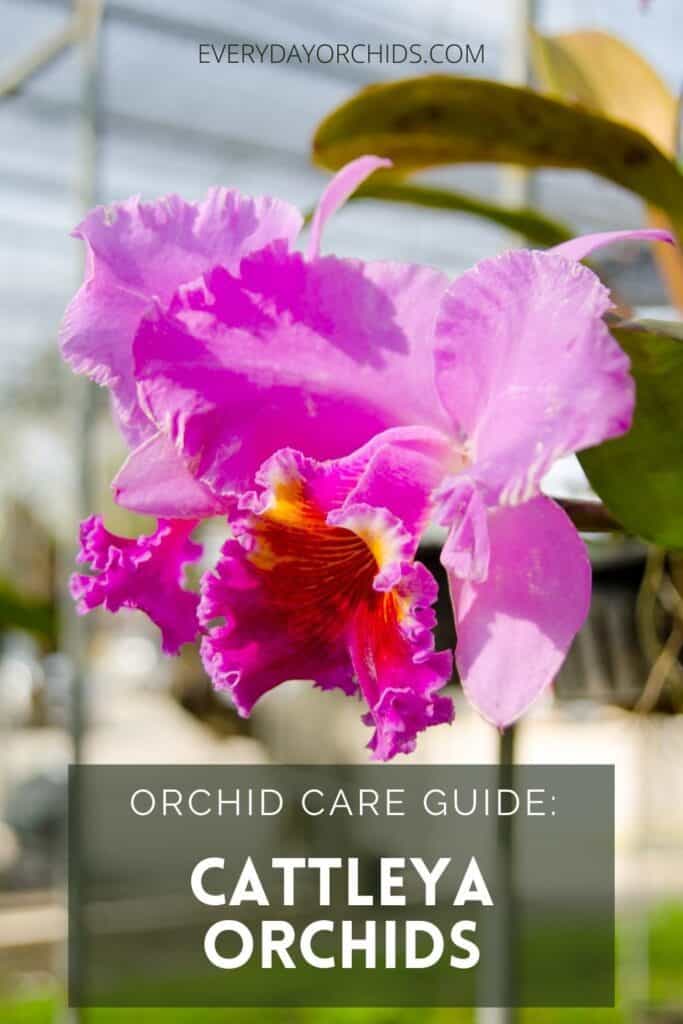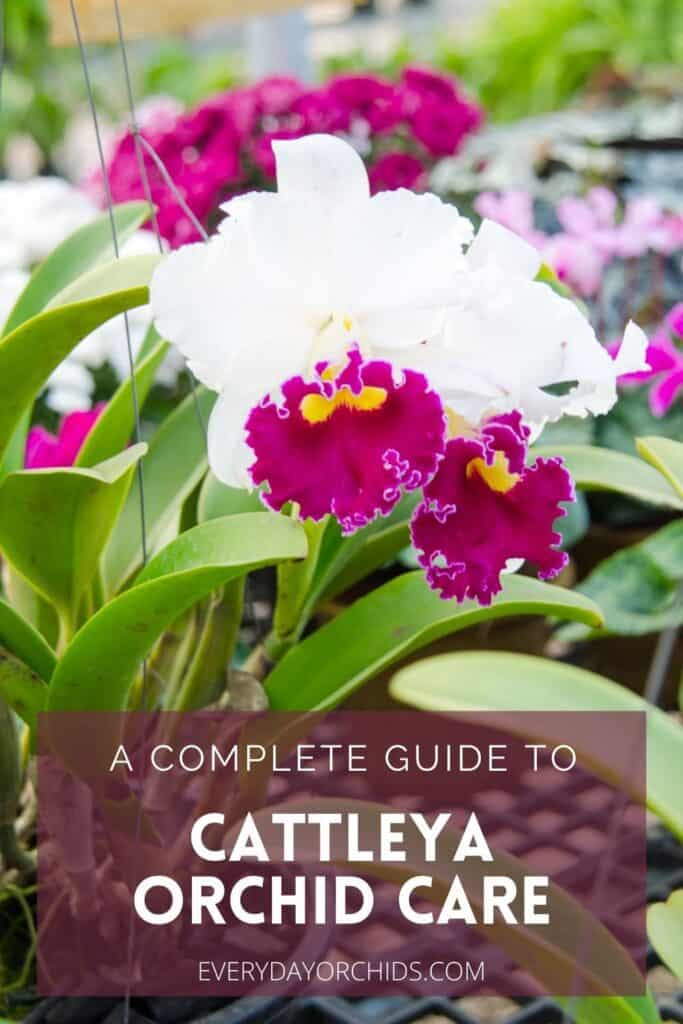If you are new to Cattleya orchids and Cattleya orchid care, welcome! You’ll be happy to know that caring for these orchids is relatively straight-forward, making Cattleya orchids accessible to anyone and everyone. Their basic care needs can easily be provided by beginner and experienced orchid growers alike.
In terms of Cattleya orchid care, these orchids require lots of bright, indirect light to grow. They like to be watered when the potting media is dry. These orchids prefer a temperature range of 70-85 degrees Fahrenheit during the day and humidity levels between 40-70%. Basic Cattleya care includes repotting every other year and feeding with an orchid specific fertilizer during the growth periods.

If you are new to Cattleya orchids, you’ve come to the right place. Here, you’ll find a complete guide to Cattleya orchid care. I’ll cover everything you need to know about these orchids, including detailed information about lighting and watering requirements, as well as temperature and humidity needs.
You’ll also learn about the basics of repotting a Cattleya orchid. I’ll outline how to divide Cattleyas and propagate new orchids. Plus, I’ll go over the common pests and diseases to watch out for. Keep reading to learn more.
Please note that these links are affiliate links and as an Amazon Associate, I earn from qualifying purchases. Purchases made through affiliate links in this post may generate commissions at no additional cost to you. Use this link for a discounted Amazon Prime trial. Thank you for your support!
Table of Contents
All About Cattleya Orchids And Their Flowers

If you already grow Phalaenopsis orchids and are looking to expand your orchid collection, Cattleya orchids are a great choice. Their care needs are similar enough to Phalaenopsis orchids that you can easily add Cattleya orchids to your collection. You won’t need to make too many changes in your growing practices to accommodate them. Before we dive into the care requirements, however, let’s talk about the flowers and the actual plant.
Cattleya orchids are epiphytes. This means that in the wild, they are typically found attached to tree trunks or branches. Cattleya orchids are also sympodial orchids. They use pseudobulbs for water storage.
Some of the more popular Cattleya varieties include the Cattleya mossiae (the Easter orchid), Cattleya percivaliana (the Christmas orchid), and Cattleya labiata.
There are also Cattleya hybrids and miniature Cattleya orchids available for sale. Depending on which Cattleya you have, the size can range from 3-inches tall for the miniature plants to up to 2-feet tall for standard Cattleyas.
Cattleya Orchid Meaning
The word “Cattleya” means “beautiful person.” This is an apt name for these beautiful orchids. Cattleya orchids are sometimes referred to as the “queen of the orchids,” because of their large showy flowers and presence. You can learn more about the symbolism and meaning of orchids here.
Cattleya Orchid Flowers
Cattleya orchids are best known for their large flowers and ruffled petals. They have the classic orchid “look” with big showy flowers. Depending on the species, Cattleya flowers can span anywhere from 2-inches to 6-inches across.
These orchid bloom colors include red, pink, lavender, white, yellow and purple. There are also Cattleya hybrids, with colored stripes, streaks, or multi-color blooms.
Each flower spike has a cluster of 2 to 6 flowers. Cattleya orchid blooms left on the flower spike can usually last for up to a month before they start to wither and die.
Many of these flowers, in addition to being so eye-catching, also have a strong fragrance or scent. This makes these orchids much-loved by growers.
Like Cymbidium orchids, Cattleya orchid flowers are often incorporated into corsages and bouquets. They are also commonly used in wedding arrangements and floral decor. With the right care, cut Cattleya blooms can last up to a week in a vase or floral arrangement.
When Do Cattleya Orchids Bloom?
Typically Cattleya orchids will bloom once a year. The blooming season will vary depending on the exact species of Cattleya orchid and can happen in the spring, fall or winter months. Some Cattleya hybrids have been known to bloom twice a year, but this is not common.
Cattleya orchids need a distinct temperature difference between day and night temps to induce bloom production.
As I will go into more detail below, Cattleya orchids have a preferred temperature range for both daytime and nighttime temperatures. Aim for a 10-20 degree difference between these day and night temperatures. This will help you to stimulate bloom production in your orchid.
Cattleya Orchid Temperature Tolerance

Standard Cattleya orchids do best when temperatures range from 70-85 degrees Fahrenheit during the day. They can tolerate temperature lows down to about 55-60 degrees Fahrenheit at night.
You can grow these orchids outdoors provided your climate has these day/night temperature ranges. However, be aware that Cattleya orchids cannot tolerate frost and colder conditions. If you live in an area that has cold nights, frost or snow, it is better to keep your Cattleya orchids indoors.
As a compromise, you can also keep them outdoors in the summer and then transition the orchids indoors during the fall. The easiest way to do this would be to plant your Cattleya orchids in pots. Use a wheeled planter base underneath to easily move the pots inside when the weather starts to cool down.
As for miniature Cattleya orchids, their temperature tolerance ranges are similar to the standard-sized Cattleyas, with the exception of daytime temps. Miniature Cattleya orchids do better with cooler daytime temperatures between 65-75 degrees Fahrenheit and nighttime temperatures between 55-60 degrees Fahrenheit.
Humidity Requirements Of Cattleya Orchids
In general, Cattleya orchids prefer humidity levels between 40-70%. If you aren’t sure of the humidity levels in your orchids’ growing area, use a hygrometer to find out.
I use this hygrometer by Thermo-Pro for my orchids and really like it. It gives me a current temperature and humidity reading, along with 24-hour ranges of the highs and lows. You can use this one or something similar in your orchid’s growing area.
If you find that your home’s humidity levels are below 40%, be sure you supplement humidity levels with a humidifier or humidity tray. Humidity levels often drop in the fall or winter and can also be naturally lower in certain regions.
I also have this humidifier in my orchid’s growing area. It helps keep humidity levels within the right range for my orchids. I use it almost daily during the cooler months and am finding my orchids grow much better with the right humidity levels.
The Importance Of Air Circulation For Orchids
When providing humidity to your Cattleya orchids, one key thing to remember is air circulation. Make sure you also have good air movement in your orchids’ growing space.
This will help prevent mold and fungal pathogens from growing. It will also help water evaporate more easily after you water your orchids. Good air circulation will also help the orchid better tolerate hotter weather or high humidity conditions.
An open window in your orchid’s growing area can provide air circulation around your plants. Just avoid placing your orchids right next to the window, as they don’t appreciate drafts.
If you prefer to keep your windows closed, you can use an oscillating fan for similar effect. When using a fan, avoid pointing the fan directly at your orchids. Instead, set it to oscillate or rotate to circulate the air in the room.
Lighting Requirements Of Cattleya Orchids

In terms of lighting, lots of indirect, bright light works best for Cattleya orchids. To prevent accidental burning of the leaves, avoid exposing your orchid to direct light.
For indoor orchids near a window, use a sheer curtain if necessary. This will help minimize the amount of direct light or afternoon sun on the orchids.
If you keep your orchids outdoors, put them in a location that will protect them from any direct sunlight. Ideally, this will not be a shaded location, as you still do want them to be able to receive a lot of indirect, bright light.
All that said, it’s possible you have the opposite problem of not enough light. If you keep your Cattleya orchids indoors and don’t have great natural lighting, you may need to supplement with artificial lighting. If you need to set this up, LED lighting tends to work well for Cattleya orchids.
How To Tell If Your Orchid Is Getting Enough Light
Now, how do you know if your orchid has enough light, too much light, or not enough light? If you aren’t sure, the quickest and easiest way to tell is by looking at the orchid leaves.
Orchid leaf color can tell you a lot about the health of the orchid, and this is applies to any orchid, not just Cattleya orchids.
Ideally, if the orchid is getting enough light, the leaves will be a nice, even grassy green color. Dark green leaves indicate inadequate lighting, while yellow orchid leaves can indicate too much light. Red-tinged leaves can also be a sign of too much light.
Adequate lighting, along with a day/night temperature difference, is key to getting your Cattleya orchid to rebloom. If your orchid is failing to rebloom and you’ve tried everything else, try increasing the amount of light exposure for your Cattleya orchids.
To learn more, read this guide on how much light orchids need.
Tips For Watering Your Cattleya Orchid

Unlike some other species, Cattleya orchids aren’t very fussy or high maintenance. If you are trying to figure out when to water your Cattleya, just pay attention to the orchid’s potting media. Water when it is dry.
Unlike many other orchids, Cattleya orchids can tolerate drying out between waterings. In this sense, a Cattleya orchid is a very forgiving plant if you tend to forget to water your orchids! However, make sure you aren’t going too long between waterings. After all, you don’t want the roots to start to dry out.
The best tip I can give you is this: Always check the potting media before you water. If the potting media is still damp, wait a day or two, then check again. If it is dry, go ahead and water. In most cases, you will likely end up watering your Cattleya orchid once a week, on average.
How To Water A Cattleya Orchid
There are different ways to water an orchid, but I prefer the soaking method the best for orchids potted in bark-based media.
In this method, I place the orchid pot in a basin of water and allow it to sit for about 5 minutes. Then I remove the pot from the basin, allowing all the excess water to run out. If you choose to follow this method, just change the water between different orchids. This way, you don’t inadvertently pass on pests and pathogens to the next plant.
You can also take your Cattleya orchid to the sink, fill the pot with water and let it run out. The difference here is that you don’t let the orchid pot sit in a basin of water and soak. You just run water through the pot and let the excess drain away.
Another tip is to water your orchids early in the morning. This will allow any excess water to evaporate or drain away before nightfall.
During cooler weather, such as in late fall and winter, orchids will not need as frequent watering. They can get by with watering every 7-10 days. As blooming season approaches and winter comes to an end, however, you’ll likely need to increase watering frequency to match the orchid’s growing needs.
If you use bark-based potting media, learn more about how to water an orchid here. If your orchid is potted in moss, you will need to use a different watering technique to avoid overwatering your orchid.
Fertilizing A Cattleya Orchid
As with any orchid, Cattleya orchids need regular fertilization with a balanced orchid fertilizer.
Look for something with a 10-10-10 NPK ratio, which can be applied year-round. You can also use a 20-20-20 NPK orchid fertilizer such as this one.
You’ll need to dilute the fertilizer before use, as outlined in this Everyday Orchids guide to fertilizing orchids. Most orchids, if not all, like weak fertilization, weekly.
As blooming season approaches, switch to a bloom booster orchid fertilizer, such as this one by The Grow Co.
In general, I recommend fertilizing during the Cattleya orchid’s active growth period, which usually happens after the orchid is done blooming. Flush out the orchid pots after every fourth or fifth fertilization with plain water. Essentially, the purpose of this is to rinse out any accumulated fertilizer salts and help protect the health of the orchid roots.
During cooler weather, such as fall and winter, orchid growth typically slows down. During this time, you can decrease fertilization to just every other week or once a month, then gradually increase again in the spring.
How To Pot And Repot Your Cattleya Orchid

As with most every orchid, the best time to repot Cattleya orchids is after they are done blooming. You’ll know the blooming season is over because all the flowers have fallen off and the orchid flower spikes have started to turn brown and dry out.
Some orchid species have a brief rest period after the blooming season before jumping into the growth phase. Repotting your orchids after the blooming season and during the growth phase is generally the best time for this task.
Cattleya orchids do best in bark-based potting media, due to their epiphyte nature. These are not orchids that have high watering needs, so they will be just fine in standard orchid potting media.
Your Cattleya orchid will need to be repotted once every 2 years. That is about how long the potting media will last before it becomes too degraded for continued use. Once the potting media has started to decompose, it will need to be replaced with new orchid potting media.
Try not to water your orchid immediately after repotting. If you had followed my guide to repotting orchids, you would have already soaked the orchid potting media in a bucket of water prior to use. Not watering the orchid immediately after repotting helps prevent problems like root rot.
Instead, allow the orchid time to adjust and acclimate to the new environment. After a few days has passed, check the potting media. If it is nearly dry, go ahead and water the orchid.
Repotting time is also a great time to divide your Cattleya orchid, since it may be starting to outgrow the current pot. I’ll go into more detail about how to divide and propagate Cattleya orchids below.
How To Propagate Cattleya Orchids

Propagating Cattleya orchids is an easy way to grow your orchid collection at little to no cost to you. Each time you repot your Cattleya orchid, you’ll likely be able to divide the orchid and expand your collection.
Once your Cattleya orchid has grown to a point where it has at least six pseudobulbs or growths, it is big enough to be divided.
Separate the Cattleya orchid into sections, leaving at least three growths per section. You may need to untangle the roots, so take your time and do separate them carefully.
Each section will need to have a minimum of one newer growth or pseudobulb on it. When dividing your orchid, use a sharp, sterilized knife or pair of gardening shears. Make clean cuts between the groups of pseudobulbs.
When you have divided your Cattleya orchid into clumps of at least three pseudobulbs, pot each cluster into separate orchid pots. Point the oldest growth towards the edges of the pot and the newer growth towards the center of the pot. This will allow room for the orchid to continue to grow.
Common Pests And Diseases
There are a number of orchid pests that growers have to deal with, but scale and thrips are the main orchid pests that tend to attack Cattleya orchids.
I’ve written about both of these pests in detail elsewhere on Everyday Orchids. Instead of detailing all the treatment options here, I’d like to point you towards the guides I’ve created.
- How to get rid of scale on your orchid.
- How to spot thrip damage on orchid plants.
- Getting rid of thrips on orchids.
- How to get rid of orchid pests. This is a general guide that includes information about thrips, scale and other common orchid pests.
As with any pest infestation, early identification and treatment is key. Regularly inspect your orchids, especially during warmer weather months such as spring and summer. This is when orchid pests are most active, and thus most likely to rapidly populate and infest plants.
When inspecting your orchids, be sure to check everywhere: under the orchid leaves, between the joints and crevices, along the stem, flower spike and flower buds, and in the potting media. There are many places where orchid pests like to hide.
Thrips, in particular, are notoriously hard to spot. In fact, thrip infestations are often identified based on the type of damage observed.
As soon as you see pests on your Cattleya orchid, take immediate steps to get rid of them. If there are just a few pests, you can probably get away with simply manually removing them with a q-tip and rubbing alcohol.
Bigger infestations will need more widespread treatment. You may need to use horticultural oils, such as neem oil, or insecticides, and do repeated applications. For more information, please check out my guides above for detailed pest control and treatment instructions.
Final Thoughts
So there you have it, a complete guide to the basics of Cattleya orchid care. If you are new to this variety of orchids or are just starting out with Cattleya orchids, I hope this guide has helped you.
All in all, Cattleya orchids aren’t very fussy and are a great option if you want to expand your orchid collection. Many of the care requirements can be easily met in most homes. With the right care, these orchids can live for years, even decades. You’ll be rewarded each year with their magnificent blooms and pops of color. As always, happy orchid growing!







